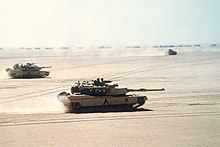

| Liberation of Kuwait | |||||||||
|---|---|---|---|---|---|---|---|---|---|
| Part of the Gulf War | |||||||||
 Two abandoned Iraqi tanks near Kuwait City (26 February 1991) | |||||||||
| |||||||||
| Belligerents | |||||||||
|
|
| ||||||||
| Commanders and leaders | |||||||||
|
|
| ||||||||
| Strength | |||||||||
| 650,000 | 500,000 | ||||||||
| Casualties and losses | |||||||||
|
1,155 casualties 70 captured |
20,000–35,000 casualties 150,000 captured | ||||||||
|
| |
|---|---|
|
Naval operations
Post-ceasefire |
The Liberation of Kuwait campaign was led by the United States between 24 and 28 February 1991, consisting of a major ground offensive into Iraqi-occupied Kuwait following the successful Gulf War air campaign. Approximately 650,000 troops of the American-led 42-country coalition swept into Kuwait to find the bulk of the 500,000 Iraqi troops surrendering en masse, but there were still pockets of resistance in some parts of the country. A particularly fierce battle took place at Kuwait International Airport, where Iraqi troops, seemingly unaware that a retreat order had been issued to them, continued to fight against the coalition's advance. By the end of February, Kuwait was declared free of the Iraqi occupation. The coalition then proceeded to push into Iraq, where the majority of the fighting occurred.[2] Shortly thereafter, combat operations ceased and the Gulf War was brought to a close.
A force composed of 40 amphibious assault ships was stationed off the coast of Kuwait and Saudi Arabia. It was the largest such force to be assembled since the Battle of Inchon.[3] Days before the attack, an amphibious force made repeated feint attacks and landings at Kuwait City, attempting to fool the Iraqis into thinking the coalition would attack via amphibious assault. Instead, the troops were to enter by the southern border of Kuwait.

At 4 a.m. on 24 February, after being shelled for months and under the constant threat of a gas attack, the U.S. 1st and 2nd Marine Divisions crossed into Kuwait. They maneuvered around vast systems of barbed wire, minefields and trenches. Once into Kuwait, they headed towards Kuwait City. The troops themselves encountered little resistance and, apart from several minor tank battles, were met primarily by surrendering soldiers. The general pattern was that coalition troops would encounter Iraqi soldiers who would put up a brief fight before deciding to surrender.[4]

On 27 February, Saddam Hussein issued a retreat order to his troops in Kuwait; however, one unit of Iraqi troops appeared to have not gotten the retreat order. When the U.S. Marines arrived at Kuwait International Airport, they encountered fierce resistance, and it took them several hours to gain control and secure the airport. As part of the retreat order, the Iraqis carried out a "scorched earth" policy that included setting hundreds of oil wells on fire in an effort to destroy the Kuwaiti economy. After the battle at Kuwait International Airport, the U.S. Marines stopped at the outskirts of Kuwait City, allowing their coalition allies to take and occupy Kuwait City, effectively ending combat operations in the Kuwaiti theater of the war.[citation needed]

After four days of fighting, all Iraqi troops were expelled from Kuwait, ending a nearly seven-month occupation of Kuwait by Iraq. A little over 1,100 casualties were suffered by the Coalition. Estimates of Iraqi casualties range from 30,000 to 150,000. Iraq lost thousands of vehicles, while the advancing Coalition lost relatively few; Iraq's obsolete Soviet T-72 tanks proved no match for the American M1 Abrams and British Challenger tanks.[5]
{{cite journal}}: Cite journal requires |journal= (help)
|
| |
|---|---|
| |
| Participants |
|
| Background |
|
| Invasion of Kuwait |
|
| Coalition intervention |
|
| Battles |
|
| Air campaign |
|
| Impact on Israel |
|
| Aftermath |
|
| Memorials |
|
| Military technology |
|